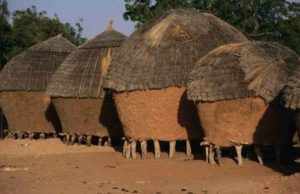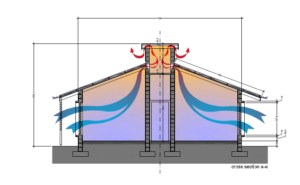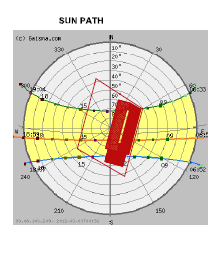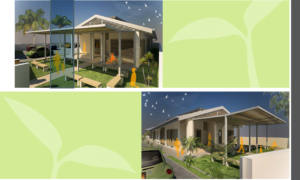Tropical Green Buildings
Introduction
Shelter is a fundamental human need. Evolution of housing is governed by human quest for shelter and geographic boundary conditions. This quest implies sustainability for any living organism. Sustainability is a function of many variables. The most prominent of these are economic, social and ecology. Economic and social sustainability implies that the cost of building it should be within the means and resources of the population. The materials and skill have to be readily available in the particular location. Organisms that poison their environment undermine their long term survival.
The concept of low energy houses or Green Buildings has been engendered by both environmental concerns and cost saving desires. The gap between holistic sustainability and economic expediency has to be bridged. Egocentricity of governments, real estate companies and individuals will not make sustainability a focal point unless sustainable options come with economic advantages. This is to say that in a situation of where energy performance regulations are absent or not stringent, the tendency is to design and build focusing on short term economic consideration.
The Nigerian situation
Here in Nigeria, the issue of ergonomics both in living and working places has not been the priority of anyone. The impression one has is that even the education curricula has not done justice to the very crucial issue of comfort combined with functionality, good esthetics, economics and sustainability. The environmental impact of every single house, the operating cost deserves deeper analysis. Although some professionals working in developing countries at times feel that the pollution war is not theirs, but that of the developed world that created most of it, the effects of pollution and climate change knows no boundaries. It is therefore irrational not to put such issues into consideration when planning our buildings.
Economic considerations have more compelling effects on how people make their choices.
The effects of Energy privatization
Under-pricing of certain services render private investment in some areas little attractive. The removal of fuel subsidy is inevitable; the privatization of power is already in progress. The implication of this as far as housing is concerned is the need for designing and constructing houses that save energy. This means that many houses we are constructing now might in a future become economically unviable due to their high cost of operation.
Consequently, many buildings will have to be upgraded. This type of intervention is normally done at much higher costs than if such facilities were initially installed. These new realities shall raise new questions for many. Clients will become more energy conscious and shall seek more guarantees when talking to their architects and designers. Prospects of alternative energy supply to buildings will be subject to better analysis. Renewable energy sources like solar energy, wind energy, geothermal could in some cases may be more viable alternatives than generators or hooking to the national grid.To achieve low energy consuming abodes there is a wide range of possibilities that are site specific.
Green Buildings Design
Our main problem is cooling, sometimes coupled with dehumidification. Unfortunately, both problems require the use of electricity or bioclimatic systems. Often the context defines the most ideal solution. Houses in the tropics ought to be cooled either artificially or by natural cooling such as ventilation methods, proper orientation, passive shedding etc.
Often the context defines the most ideal solution. Houses in the tropics ought to be cooled either artificially or by natural cooling such as ventilation methods, proper orientation, passive shedding etc.
The decision to follow one method or the other changes the entire concept of the optimal shape the building is supposed to have.
Case Study


If we opt for air-conditioning, then the building should be air-tight. And the optimal shape is that with the least external surface area and high insulation. Maximum insulation will reduce to a good extent the operational cost of the house. Heat gains are from the envelope mainly.
Thermal insulation of a building is not easy in many African countries due to lack of viable insulating material. Polystyrene, polyurethane, rock wool, wood fibers and many other types of insulators are not produced locally and their mere volume makes their importation uneconomical.
- Adaptive building concept
- Smart House concept

A common future of all these concepts is the saving of energy and production of it in some cases. Due to lack of financial resources in our economy, I believe that pragmatism is the best approach. It will be foolhardy dabbling into ideas that we might not have the technique, expertise, even materials to realize. Instead it would be wrong not to carry out the interventions within our reach like adaptive building method, insulation and bioclimatic designs to make our dwellings as passive as possible.


ANTHILL
 At Bioclima Energetics our Architects and Engineers are trying to imitate the termite. Under the thick hard shell there is soft comfort. Our carefully
At Bioclima Energetics our Architects and Engineers are trying to imitate the termite. Under the thick hard shell there is soft comfort. Our carefully
Conclusions
- Maximal insulation of both the transparent and opaque portions of the envelope and minimal installations; local production of renewable energy like electricity produced by renewable sources like photo voltaic kit could make a house low energy consuming and at times energy self-sufficient. Energy-saving household appliances: Low energy refrigerators, freezers, lamps are to become norm.
- Solutions to meet energy demand are never a good alternative; it is like first creating a disease then after, searching for cure.
- Take an integrated design strategy. Be aware that different technologies influence each other.
- Buildings ought to be seen in the overall energy demand and supply system. Sub optimal choices to reduce the energy consumption and pollution should be avoided.
- The concept of Green Building is engendered by both environmental concerns and the economics; Cost-benefit analysis on one hand and the optimization of available scarce resources on the other. This set of considerations brings us to that of sustainability.
- Sustainability imposes optimization of energy efficiency through proper engineering of the building envelop energy use and design of the external environment. The main objective being the limitation of heat gains from the external environment.
- In the design of structures it is necessary to create comfort through bioclimatic methods. To ensure high air circulation, large windows working in synergy with ventilation towers-solar chimney, external vegetation, ceiling fans.
- Sustainability is not simply a slogan.
( by Dr. Engr. Christopher Ezeifedi, Trento, Italy mobile Nigeria : 08069696181, mobile Italy: +393389194453, prismati@yahoo.co.uk)
All rights reserved
